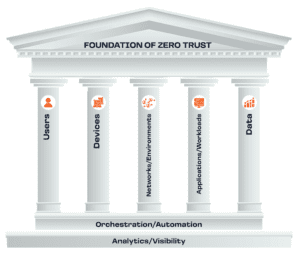What is Zero Trust?
Zero Trust (ZT) is an active security paradigm that prioritizes users, assets, and resources over traditional network security methods. Rather than relying on location or asset ownership, the default assumption is to “never trust, always verify” and the system continuously monitors activities via logging, filtering, and analysis to identify user behavior patterns and any anomalies that may arise.
A key aspect of ZT assumes that both internal and external networks are compromised or potentially compromised, and it seeks to minimize the impact of any potential breach by implementing strict access controls and continuous monitoring. The strategy aims to verify the identity of all users and devices attempting to access network resources, as well as ensure that they have the appropriate permissions to do so.
Key elements of ZT include:
- Identity-Based Access Controls: Users and devices are authenticated and authorized based on their unique identity attributes, such as user credentials, device health status, and context of the request.
- Least Privilege: Users and devices are granted only the minimum level of access required to perform their tasks, limiting the potential damage that could be caused in the event of a compromise.
- Micro Segmentation: Networks are divided into smaller, isolated segments or zones to minimize lateral movement within the network. This helps contain potential breaches and restrict unauthorized access to sensitive resources.
- Continuous Monitoring and Analytics: Ongoing monitoring of network traffic, user behavior, and device health allows for real-time detection and response to potential threats or anomalies.
- Encryption and Data Protection: Data is encrypted both in transit and at rest to protect its confidentiality and integrity.
- Multi-Factor Authentication: Multiple forms of authentication, such as passwords, biometrics, or smart cards, are used to verify user identities and enhance security.

It all starts with an Architecture
The DoD has issued a mandate that all weapons systems must be secured by a fully implemented DoD wide Zero Trust Architecture (ZTA) comprised of guiding principles for workflow, system design and operations.
The ZTA centers around a data-centric approach, commencing with user authentication and authorization. Next, policy points are established, which include a Policy Decision Point and a Policy Enforcement Point. The Policy Decision Point determines the confidence level of a user, while the Policy Enforcement Point connects users to requested resources in accordance with the segmentation policy.
Many components of ZT are already prevalent in networks today, but there are many things left to be implemented and some concepts are difficult to apply to existing projects, and all with a different timeline implementation mandate to be completed by FY2027 according to the DoD.
How Parry Implements ZT
It is crucial to recognize that there is no single product that can provide a complete ZT solution. Parry Labs is embracing the true nature of what ZT is trying to achieve by embedding security not just at our corporate level but accelerating the adoption of ZT into all our products with a phased rollout. This approach is clear with Parry Lab’s Stratia software operating environment, inclusive of our software defined intelligent network approach which implements several ZT pillars and provides a modular architecture to be able to extend to other capabilities. By focusing on more than just network security and instead having an overarching architecture, the company is internally investing in and combining with technologies coming out of other cyber efforts to integrate this holistic approach. From verifying that the correct software is loaded and running on the hardware to being able to log cyber events in real-time, allowing users to investigate issues quickly, Parry Labs is providing various levels of protection needed to protect our Warfighters and the weapon systems they operate.